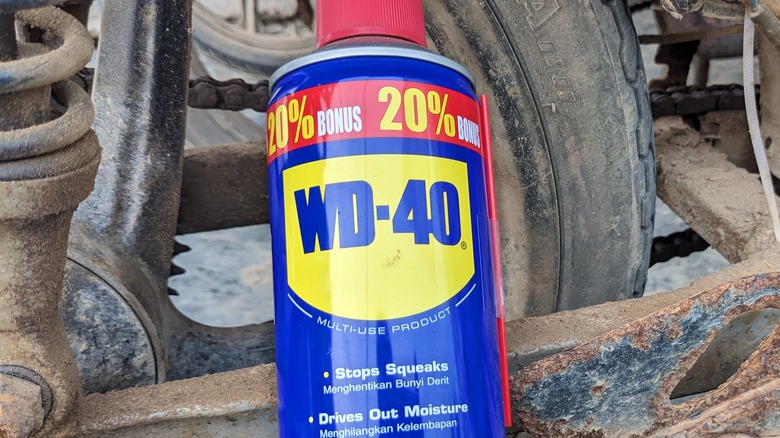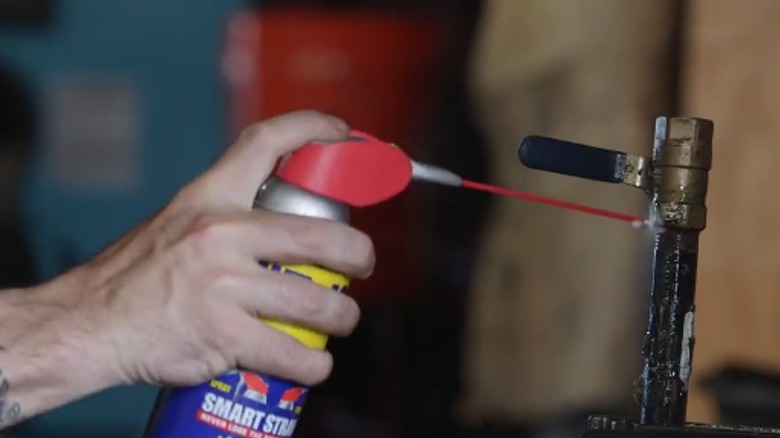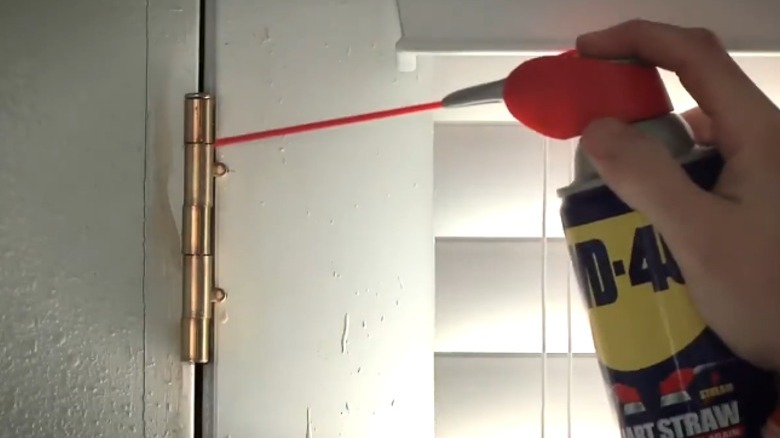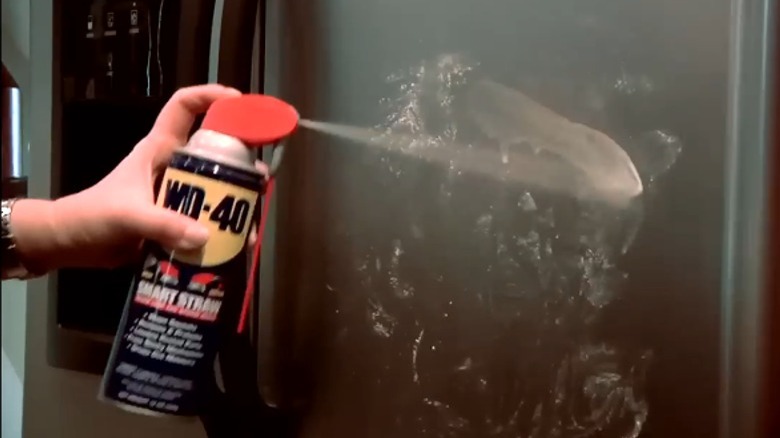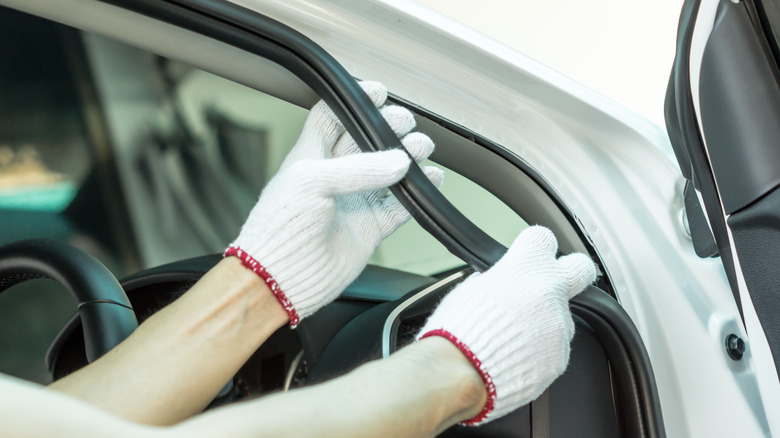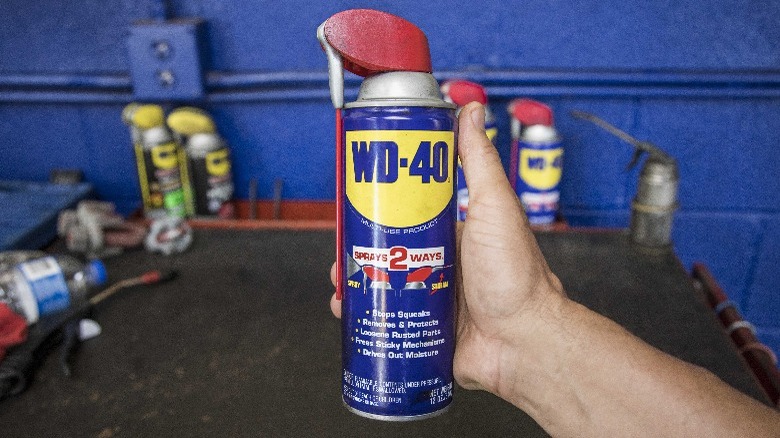6 Practical Uses For WD-40 Around The Garage
WD-40 is a fascinating compound. It was first invented in 1953 by Rocket Chemical Company as a hybrid degreaser and rust-prevention solvent for the aerospace industry. Its commercial applications quickly became apparent, however. There's an old engineering expression that you can fix just about anything with enough WD-40 and duct tape. If it moves and shouldn't move: duct tape. If it doesn't move and should: WD-40.
But folksy anecdotes aside, you might be surprised to learn just how versatile that little blue and yellow aerosol can actually is. There are tons of WD-40 hacks out there. People have recommended WD-40 for everything from breaking in baseball mitts to keeping bugs and spiders from getting into your house through your doors and windows.
And there are a lot of different practical uses for WD-40 in your own garage. It doesn't matter if you restore old cars, practice woodworking, or just enjoy taking care of some home DIY repairs. There are at least a dozen ways WD-40 can make your life a little easier. Here are six of this magic spray's most useful practical applications for your garage.
Loosening fasteners
Have you ever been changing a tire only for one stubborn lug nut to refuse to break, no matter how much leverage or torque you throw at it? WD-40 can help. Of all the uses that WD-40 has, it's perhaps most well-known for its ability to help break loose stuck fasteners. Bolts, screws, rivets, or any stubborn piece of metal that just doesn't want to come free are all much easier to work with after a liberal application of this spray.
WD-40 is a lubricant. This means that moving parts will slide more easily when it's applied. That obviously helps, but there is actually another reason why WD-40 is particularly suited to loosening fasteners. The compound breaks down the oxidation and corrosion that fills the gaps between the fastener and the things it's attaching.
All you have to do is spray the seam and then give the WD-40 about 3-5 minutes to work its way through the gaps and break down these adhesive-like compounds so that your fasteners will come loose the way they were originally intended. In fact, pre-soaking your nuts and bolts in WD-40 prior to assembly will allow the compound to seep into the pores of the metal which makes assembly easier and adds a protective coating that prevents corrosion from taking root in the first place. The company sells non-aerosol liquid containers of the product for exactly this purpose.
Quieting squeaky hinges
Squeaky hinges may not affect the functionality of doors and drawers, but they're certainly annoying. Unless you're a sitcom dad who wants to catch a teenager sneaking out of the house to go to a party, you'll probably want to fix this issue as soon as you notice the sound. It doesn't matter if it's your car door, your workbench drawers, or a set of pliers, no one wants to hear the whine of metal scraping against metal when they're trying to open something. Fortunately, this is another area where WD-40 excels. Its lubricating properties eliminate squeaking sounds from most kinds of metal hinges.
All you have to do is spray the solvent into the gaps, wipe off the excess, and then give it a few swings to help the compound work its way into all the nooks and crannies. Using the straw attachment can help target these narrow gaps so can you get more fluid into the hinge and keep drippage to a minimum. This will break down any corrosion that has built up between the gaps in the hinges and lubricate the swinging parts so that their rubbing together will no longer produce a sound. This will also make your hinges swing smoother and more easily.
Preventing and removing rust
Garages are great, but they're generally not quite as weatherproof as the rest of your house. Even if the walls are sealed, that big rolling door is probably going to let in a bit of moisture. This means that the tools, vehicles, and other metal objects in there may end up developing rust.
Everything from wrenches and screwdrivers to metal workbenches and steel baseball bats issusceptible to corrosion. All it needs is iron, oxygen, and water, and the red plague will spread across the metal.
WD-40 can help prevent this. All you need to do is take a cloth coated in the spray and use it to wipe down all of your metal surfaces. This will create a barrier between the metal and the water molecules, preventing them from being able to form a chemical bond.
WD-40 is also a garage essential when it comes to easy rust removal. There are several other methods for removing rust from rusty old tools, but WD-40 is quick, easy, and cheap. It's also the only method that seals the metal to protect it from further erosion as you're cleaning it. All you need to do is spray the affected area, let it sit for about 10 minutes, and then scrub it with something coarse, like some fine-grit sandpaper. The company also sells a Specialist Rust Penetrant Spray which can be even more effective than the standard formula for removing deep-rooted rust.
Shining steel and protecting paint
WD-40 doesn't just protect your steel surfaces, it can also polish them up to a mirror-like shine. This can be nice for a lot of different surfaces. You may or may not care how shiny your wrench collection is, but there are probably a few items that could use a good cleaning. If you have a stainless steel fridge, or any chrome or raw steel accents on your vehicle, such as the bumpers or exhaust, you can use WD-40 to remove smudges and fingerprints, making them look clean, shiny, and new.
You can even spray and wipe down the painted parts of your car after you wash it if you want to. This will add a protective layer that will help prevent rust and keep your car cleaner for longer, as dirt and debris will be less likely to stick. It's worth noting that some publications have stated that some of the chemicals in WD-40 can be harmful to paint over time, but there are others, like Torque Detail, that disagree. "The individual components in WD-40 can be harmful to paintwork. The isoparaffinic aliphatic hydrocarbons, for example, are very similar to kerosene. Kerosene would destroy your clear coat, so people sometimes claim that WD-40 would do the same," they state. "However, the ingredients are not used individually. WD-40 is mixed to precise proportions, and once it's mixed together, the ingredients are safe on your paint."
Soften weather stripping
Cars and trucks need weather stripping on their doors and windows. It creates a barrier between the metal that the door and frame are made of in order to prevent airflow around the gaps. This is good for temperature control, maintaining cabin pressure, and keeping out moisture. These are made of a supple material called medium-density sponge rubber, which creates a powerful seal that is also temperature and environmentally resistant — so long as they are in good condition.
They don't last forever, though. This kind of weather stripping can become dried out over time, which makes it hard and brittle. This eventually results in cracking and tearing, which can in turn lead to several unpleasant side effects. You may notice noise as air gets into the cabin while you drive. Your car may struggle to maintain its temperature control, as the heating and air conditioning will leak from the poorly sealed cabin. In some cases, moisture might get inside the car, which can lead to mold and mildew if the problem isn't addressed. A quick spray of WD-40 can soften up stiff weather stripping and prolong the life of the seal. The company also makes a Specialist High-Performance Silicone formula that can be used to protect these areas and prevent them from hardening in the first place.
Clean and maintain machines with moving parts
Mechanisms with moving parts can run into all kinds of trouble when they get dirty. Everything ,from simple padlocks to complex auto parts, can cease to function as soon as a bit of dirt gums up something that's supposed to move freely. WD-40 can help with this. Its solvent properties make it excellent at getting into the narrow gaps between components and freeing up the mechanisms to work the way that they're supposed to. Its lubricant properties are also helpful for keeping those moving parts going. This is especially important when it comes to power tools.
That said, it isn't the best lubricant for certain jobs. Basic Multi-Use WD-40 is good enough to keep a pair of shears opening and closing, but for more advanced mechanical components such as locks and bicycle chains, you will be better off using a silicone-based lubricant. These last longer and provide a higher degree of mobility to the moving components. As mentioned before, WD-40 does make a silicone spray that is much better suited to these tasks than the standard formula. It also makes a spray that is specifically designed to be used as a bike chain lube.
